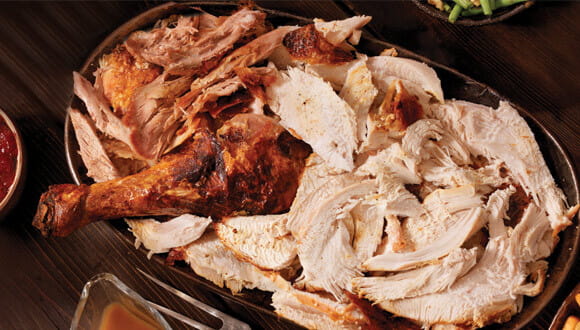Dark Meat Vs. White Meat: Is One Cut of Turkey Really Healthier Than the Other?
Nov. 16, 2021 - Katie McCallumWhen it comes to poultry preferences, we all have our personal favorite: white turkey meat or dark turkey meat. And there's no time like holidays to debate which is best.
You might dig into the plentiful pile of turkey breast, which is typically considered the "healthier" choice. You can probably eat more turkey that way, right?
Or maybe you gravitate toward the thigh meat or enter into the who-gets-one-of-the-drumsticks lottery. Both parts are widely regarded as the moister choices.
We'll leave the debate of which is tastier for the Thanksgiving table, but Emma Willingham, clinical dietitian at Houston Methodist, is here to answer whether one cut of meat is really healthier than the other.
What's the difference between white meat and dark meat?
The main difference between white meat and dark meat is where on the bird the meat comes from.
"The darker the meat, the more myoglobin it contains," says Willingham. "Myoglobin is the protein found in muscle tissue that carries oxygen. In turkeys and chickens, dark meat is sourced from the leg or thigh. These animals carry more myoglobin in these locations in order to help deliver oxygen to their muscles as they run around. They need their exercise, too!"
White meat includes:
- Breast meat
- Breast tenders
- Wings
Dark meat includes:
- Thighs
- Drumsticks (legs)
Poultry nutrition: Is white meat really healthier than dark meat?
Turkey and chicken are both high in protein. But the darker cuts of these birds sometimes get a bad rep, usually because they're considered fattier.
Fat may be dense in calories and best consumed in moderation, but it's an essential part of our diets. Plus, not all fats are created equal.
- Unsaturated fats, which include monounsaturated fats and polyunsaturated fats, are considered protective since they boost heart health and improve cholesterol levels.
- Saturated fats, on the other hand, are less protective and, when eaten in excess, may increase a person's risk of heart disease over time.
"Both dark meat and white meat are high in protective, unsaturated fats," says Willingham. "And while dark meat does also contain double the amount of less protective, saturated fat, it's also packed with micronutrients that play important roles in the metabolism of protein, carbs and fat. Overall, white meat is actually less nutrient dense than dark meat."
In particular, dark meat contains significant amounts of iron.
"The iron found in dark meat is absorbed and used by the body much more easily than the iron found in plant-based foods," says Willingham. "This makes it an excellent choice for anyone with iron-deficiency anemia, which is common in women, especially before menopause."
White meat has its perks, too, though. It's higher in energy-producing B vitamins and contains slightly fewer calories and saturated fat than dark meat.
So in the battle of dark meat vs. white meat, is one really a healthier option than the other?
"Both white meat and dark meat offer solid nutritional value and can be incorporated into your Thanksgiving plates!" says Willingham.
In fact, the greatest nutritional threat to consider when it comes to poultry may actually be the skin — whether it's on white meat or dark meat.
"Turkey (and chicken) skin adds even more saturated fat to your plate," adds Willingham. "It's okay to enjoy poultry skin on occasion, but if you're trying to watch your cholesterol or minimize added calories, it would be a good idea to remove the skin before enjoying your personal favorite cut of meat."








